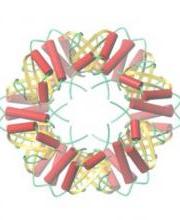SP1 as a nanopore for "nanopore sequencing"

A biological nanopore consists of a pore-forming protein which is embedded into the lipid bilayer. An analyte is driven through the pore by applying voltage to the system, while the ionic current is monitored throughout the process. During the translocation of a DNA molecule through the pore, each nucleotide generates a unique electrical “fingerprint”. Repeating this process with numerous, consecutive, nucleotides can be used to perform DNA sequencing.
Stable Protein 1 (SP1) is a ring-shaped, highly stable, homo-dodecamer protein which was first isolated from Aspen trees. Due to SP1 stability under extreme conditions and its symmetrical inner pore, it can be used as nanopore. Recently we have demonstrated that SP1 can be embedded into lipid bilayers and create biological nanopores.
Collaborators: Prof. Danny Porath and Prof. Daniel Mandler (Hebrew University), Oxford Nanopore Technologies
Figure: X-ray reconstruction of SP1
